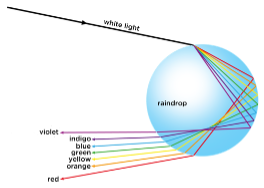Rainbows
Overview: Rainbows occur naturally when sunlight is dispersed by raindrops into the color spectrum. Rainbows are always in order of wavelength from longest to shortest: red, orange, yellow, green, blue and violet.
Supplies: Black cloth, small glass beads, sunlight or flashlight
Objectives: Show how dispersion of light through water droplets (or something mimicing water droplets) can make rainbows. Show that the order of colors will always be the same based on wavelength.
Setup:
- Spread the black cloth on the ground or a table
- Disperse the glass beads on the cloth
- If using sunlight, stand with the sun behind you
How to run the demo:
- If using sunlight, stand with the sun behind you
- Adjust your position and angle until the glass beads reveal rainbow colors
- If using a flashlight, shine the light on the beads at an angle to reveal a rainbow of colors
What’s Happening?
Rainbows happen by 3 optical phenomenon called refraction, reflection and dispersion that happen when light enters and then exits a raindrop.
The incoming sunlight first refracts, or changes direction and disperses, or spreads out, when it enters the raindrop. The light then reflects off the back side of the drop. Finally, the light refracts and disperses for a second time as it exits the drop and we see the white light spread out to all the colors of the rainbow.

We don’t see rainbows every time it rains, though. Three things need to happen in the sky to see a rainbow. First, there have to be water droplets in the air. Second, the sun has to be behind you. Third, the sun has to be low in the sky. When we put all these things together we end up in the center of the arch of a rainbow.
Learn more: (external links)

